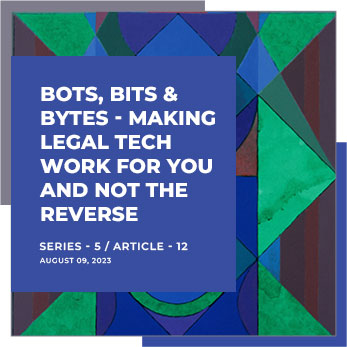Can a paralegal practice law? One would expect the strict answer to be ‘no’. However, following the American Bar Association’s (ABA) 2020 definition of ‘paralegal’, a wide range of truly substantive legal work can now be lawfully assigned to a paralegal.
The key qualifier as to the assigning of legal work is that the lawyer remains responsible for that work. It is critical to keep the distinction between what a licensed attorney can do and what he or she may supervise in order to adhere to ethical principles.
Standing Committee on Paralegals
In 1997, the ABA House of Delegates adopted a resolution that allowed for the terms ‘paralegal’ and ‘legal assistant’ to be used interchangeably. Indeed, in her noteworthy 2015 article, ‘The Changing Role of Legal Support Staff’, author Cynthia Thomas wrote: “Recent advancements in technology used by law firms have blurred the lines between legal assistants/paralegals and legal secretaries. What were once two separate and distinct positions now overlap, and both jobs have changed significantly.”
However, that blurring of lines changed at the February 2020 ABA Midyear meeting, when the House of Delegates adopted the recommendation of the Standing Committee on Paralegals, eliminating the term ‘legal assistant’ from the definition and refining it to read: ‘A paralegal is a person, qualified by education, training, or work experience, who is employed or retained by a lawyer, law office, corporation, governmental agency, or other entity and who performs specifically delegated substantive legal work for which a lawyer is responsible.’ (ABA House of Delegates, 2020.)
But What is ‘Substantive Legal Work’?
Basically, ‘substantive legal work’ refers to legal work that could otherwise be done by an attorney, and goes far beyond mere clerical support duties. The paralegal can, for example, interview clients, conduct legal research, draft documentation for client transactions, draft pleadings and notices of discovery, review client files, assist the attorney at real estate closings and other commercial transactions, and even assist at trial.This trend is visible in the legal recruitment industry. Firms are instead seeking senior trust and estates paralegal with a strong background in the legal fields, accounting, taxation, and most importantly, mathematics. If a firm hires the ‘right’ talent for the role, the entire practice area can benefit as one skilled paralegal can execute the tasks of many expensive professionals in a single go.
So, what can’t the paralegal do? The paralegal cannot enter into the attorney-client relationship on behalf of the attorney, nor establish what fees will be charged for the legal work, nor offer any legal advice whatsoever. The paralegal is further prohibited from representing clients in a court of law, signing pleadings, taking depositions, or doing anything else that might constitute the unauthorized practice of law in a particular jurisdiction.However, even within those parameters, there are variations from state to state, with some states permitting nonlawyers to appear before certain administrative proceedings. Among Federal agencies, the Social Security Administration in particular, allows paralegals to actually represent clients during a Social Security Disability hearing held before an ALJ. Similarly, some states permit their in-house corporate paralegals to appear in hearings as client representatives – i.e., as corporate officers rather than as legal agents on behalf of the company.
Practice Profitability
The truth is, that most lawyers are quite ‘overqualified’ for much of the daily work that dominates their practice. One scenario estimated that if an attorney working without a paralegal was required to spend on average forty hours on each file, a year of work hours would likely limit the number of files that the attorney could handle in a year to 35-40 files. But if the lawyer can cut his or her own time handling each file down to just 16 hours, then the number of files per year jumps to over ninety. Viewed in terms of case volume turnover, the difference is significant.
A parallel consideration is the hourly billing rate differential: while it is true that the attorney might bill out at anywhere from $250-$400 per hour, while the paralegal’s billable rate to the client might be closer to $100-$200 per hour, applying those figures to the above time/file analysis demonstrates that shifting permissible legal work to the paralegal pays off.
From Paralegal to Associate Attorney – a welcome change?
One would assume that the answer to the above question is a resounding ‘yes’, but they would be mistaken to think that’s the industry preference.
While the transition from paralegal to attorney appears to be a logical career move for most, if it’s done without the ‘blessing’ by the paralegal’s supervisors in a practice the change may not be welcome with open arms. First and foremost, the transition throws-off the economics of the firm’s billing arrangements with the clients and the internal budgeting for a case in relation to the pricing for their services. Secondly, putting it bluntly, paralegals are hired for substantive support – not as part of an attorney’s ‘succession plan’ within the firm where younger attorneys are – in theory – ‘mentored’ to eventually replace the older partners.
Paralegals are often hired for intensive support roles within an attorney’s caseload, and if that professional were to transition to a more prominent attorney role, it would once again necessitate a new paralegal hire, which in-turn frustrates the original purpose of hiring a paralegal in the first instance and the economics of the situation, thereby creating a vicious cycle of repeat hires and costs.
“PARALEGALS ARE OFTEN HIRED FOR INTENSIVE SUPPORT ROLES WITHIN AN ATTORNEY’S CASELOAD….
…A WIDE RANGE OF TRULY SUBSTANTIVE LEGAL WORK CAN NOW BE LAWFULLY ASSIGNED TO A PARALEGAL”
Law firms, or any employer for that matter, do not appreciate an employee ‘backdooring’ themselves into a different position when they were hired for a specific task – which is how an unexpected switch from paralegal to barred attorney can feel if it happens without notice. This doesn’t mean paralegals are prohibited from ever making such a switch. In-fact, it is a very common career path for many successful attorneys. However, making the switch does necessitate-
- Prior consultation with one’s supervising attorneys or Partners is required if the paralegal wishes to continue as a lawyer in their present firm at a future date.
- Reasonable notice regarding the transition so that management has time to prepare and budget their resources to accommodate the new lawyer at their firm.
- Flexibility and commitment from both ends, to accommodate schooling, more responsibilities, and a higher quality of service to the clients.
In cases where the paralegal and the firm decide to part ways due to costs, clashes, or otherwise, both parties must be ready to bear the risk of losing one another, which is a common business decision that must be taken. If a law firm creates and implements an internal system of ushering paralegals into law school and beyond, it can create long-term loyalty from the employee and value for the firm as the new attorney returns to the firm fully formed and pre-trained in the firm’s protocols. The ‘practice of profitability’ should also be accompanied by risk-analysis on the retention and loss of potential human resources who can be grown intofull-fledged attorney in the long term.
ABA Model Guidelines
To further assist the attorney in understanding the do’s and don’ts of delegating legal work to a paralegal, the ABA’s Standing Committee on Paralegals updated the Model Guidelines in 2021 to include legal and policy developments that have taken place since the last update in 2012.The Standing Committee believes that the guidelines will encourage lawyers to utilize paralegal services effectively while at the same time promoting continued growth of the paralegal profession. The Standing Committee advises that lawyers first review Model Rule 5.3 in the course of utilizing paralegal services, and notes that nothing in the Model Guidelines is intended to be inconsistent with that rule.
Furthermore, the lawyer should familiarize himself or herself with the applicable ethical considerations, ethical rules, and case law in each state in order to avoid running afoul of those established parameters. Further assistance may be sought from paralegal professional associations such as the National Federation of Paralegal Associations, Inc. (NFPA), or the NALA paralegal organization. The full text of the ABA Model Guidelines may be found at: ABA Model Guidelines for the Utilization of Paralegal Services (PDF). With proper utilization of a qualified paralegal, your practice’s productivity and profitability will both reap the benefits.
“…LAWYER SHOULD FAMILIARIZE HIMSELF OR HERSELF WITH THE APPLICABLE ETHICAL FACTORS…”
Executive Summary
1. The Issue
With the ever-increasing importance of paralegals in the practice of law, the ethical lines of what ‘can’ and ‘can’t’ be done by these legal professionals have become blurred.
2. The Gravamen
Though paralegals are irreplaceable and cost-effective resources for a firm, the attorney charged with the matter must not abdicate their responsibilities with respect to ‘substantive legal work’.
3. The Path Forward
Ethical responsibilities must drive workload assignment – with substantive legal duties remaining with the attorney or, at a minimum, under rigorous attorney supervision.
Action Items
1. Identify functions in need of paralegal support
Small and medium sized firms manage case matters in different ways depending on what suits the practice and the attorneys best. Within the matter lifecycle, there are many ‘background’ support tasks that are often time-consuming and take away an attorney’s ability to engage in ‘substantive’ legal work. For many law firms, hiring an associate may be an expensive proposition, or perhaps the functions are too limited to support a junior attorney. This is where a paralegal can serve as an irreplaceable ‘right hand’ to the attorney.
2. Consider the scope of duties intended for the paralegal
This analysis always takes place in relation to the firm’s practice area and volume of matters internally. An immediate consideration should be- what tasks can be assigned to my paralegal within the range of duties that exist within this legal spectrum. This will help the supervising attorney discern what job functions should not be assigned to the paralegal.
3. Hire with a vision
Some legal professionals are ‘career paralegals’ while others utilize the experience as a valuable stepping stone to becoming a law practitioner. Both scenarios hold their own pros and cons, and both should ideally be discussed internally with an open mind toward the future growth strategies of the firm.
4. Supervise until situated
Once the paralegal is hired, it is recommended that their work be closely supervised by an attorney until it’s clear what the case management obligations are within the firm. Ethical considerations should ideally be inculcated directly into the internal workflow between the attorney and paralegal.







